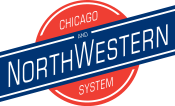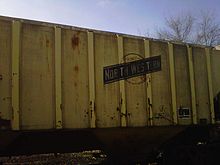- Chicago and North Western Transportation Company
-
"CNW" redirects here. For other uses, see CNW (disambiguation).
Chicago and North Western Transportation Company 
Map of the C&NW. Black lines are trackage now owned by Union Pacific; green lines are trackage now owned by Canadian Pacific Railway (operated by DM&E); blue lines are now owned by other railroads; dotted lines are abandoned.Reporting mark CNW Locale Illinois, Iowa, Kansas, Michigan, Minnesota, Missouri, Nebraska, North Dakota, South Dakota, Wisconsin, and Wyoming Dates of operation 1865–1995 Successor Union Pacific Track gauge 4 ft 8 1⁄2 in (1,435 mm) (standard gauge) Headquarters Chicago, Illinois The Chicago and North Western Transportation Company (reporting mark CNW) was a Class I railroad in the Midwest United States. It was also known as the North Western. The railroad operated more than 5,000 miles (8,000 km) of track as of the turn of the 20th century, and over 12,000 miles (19,000 km) of track in seven states before retrenchment in the late 1970s. Until 1972, when the company was sold to its employees, it was named the Chicago and North Western Railway. The C&NW became one of the longest railroads in the USA as a result of mergers with other railroads, such as the Chicago Great Western Railway, Minneapolis and St. Louis Railway and others. By 1995, track sales and abandonment had reduced the total mileage back to about 5,000. The majority of the abandoned and sold lines were lightly trafficked branches in Iowa, Illinois, Minnesota, South Dakota and Wisconsin. Large line sales, such as those that resulted in the Dakota, Minnesota and Eastern Railroad further helped reduce the railroad to a mainline core with several regional feeders and branches.[1] The company was purchased by Union Pacific Railroad in April 1995 and ceased to exist.
Contents
History
The Chicago and North Western Railway was chartered on June 7, 1859. It had purchased the assets of the bankrupt Chicago, St. Paul and Fond du Lac Railroad five days earlier. On February 15, 1865, it officially merged with the Galena and Chicago Union Railroad, which had been chartered on January 16, 1836. Since the Galena & Chicago Union started operating in December 1848, and the Fond du Lac railroad started in March, 1855, the Galena and Chicago Union Railroad is considered to be the origin of the North Western railroad system.
The North Western had owned a majority of the stock of the Chicago, St. Paul, Minneapolis and Omaha Railway (Omaha Road) since 1882. On January 1, 1957, it officially leased the company, and merged it into the North Western in 1972. The Omaha Road's main line ran from an interchange with the North Western at Elroy, Wisconsin, to the Twin Cities, down to Sioux City, Iowa, and then finally to Omaha, Nebraska.
The North Western picked up several important short railroads during its later years. It finalized acquisition of the Litchfield and Madison Railway on January 1, 1958. The Litchfield and Madison railroad was a 44-mile (71 km) bridge road from East St. Louis to Litchfield, Illinois. On July 30, 1968, the North Western acquired two former interurbans – the 36-mile (58 km) Des Moines and Central Iowa Railway (DM&CI), and the 110-mile (180 km) Fort Dodge, Des Moines and Southern Railway (FDDM&S). The DM&CI gave access to the Firestone plant in Des Moines, Iowa, and the FDDM&S provided access to gypsum mills in Fort Dodge, Iowa.
On November 1, 1960, the North Western acquired the rail properties of the 1,500-mile (2,400 km) Minneapolis and St. Louis Railway. In spite of its name, it ran only from Minneapolis, Minnesota, to Peoria, Illinois. This acquisition provided traffic and modern rolling stock, and eliminated competition.
On July 1, 1968, the 1,500 mi (2,400 km) Chicago Great Western Railway was merged into the North Western. This railroad went from Chicago to Oelwein, Iowa. From there, separate lines went to the Twin Cities, Omaha, Nebraska, and Kansas City, Missouri. A connection from Hayfield, Minnesota, to Clarion, Iowa, provided a Twin Cities to Omaha main line. The Chicago Great Western duplicated the North Western's routes from Chicago to the Twin Cities and Omaha, but went the long way. This merger provided access to Kansas City and further eliminated competition. After abandoning a plan to merge with the Milwaukee Road in 1970, Benjamin W. Heineman, who had headed the CNW and parent Northwest Industries since 1956, arranged the sale of the railroad to its employees in 1972. The words "Employee Owned" were part of the company logo in the ensuing period.
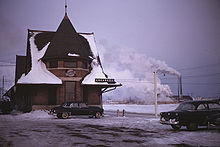 C&NW railway station in Escanaba, Michigan - 1953
C&NW railway station in Escanaba, Michigan - 1953
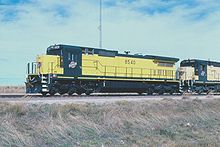 C&NW #8540 at Shawnee, Wyoming
C&NW #8540 at Shawnee, Wyoming
After the Chicago, Rock Island and Pacific Railroad (Rock Island) stopped operating on March 31, 1980, the North Western won a bidding war with the Soo Line Railroad for purchase of the roughly 600-mile (970 km) "Spine Line" from the Twin Cities to Kansas City, Missouri, via Des Moines, Iowa. The North Western's bid of $93 million was approved on June 20, 1983, by the ICC. The line was well-engineered, but because of deferred maintenance on the part of the bankrupt Rock Island, a major rehabilitation was undertaken in 1984. The North Western then began to abandon the Oelwein to Kansas City section of its former Chicago Great Western trackage, which duplicated Spine Line service.
In April, 1995, the Chicago and North Western Transportation Company was merged into the Union Pacific Railroad.
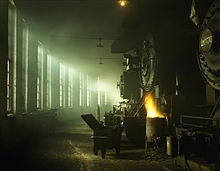 Steam locomotives of the Chicago & North Western Railway in the roundhouse at the Chicago rail yards (December 1942)
Steam locomotives of the Chicago & North Western Railway in the roundhouse at the Chicago rail yards (December 1942)
Chicago and North Western locomotives continued to operate in their paint schemes for several years after the merger. As of 2011, two locomotives remain on the UP with CNW logos and reporting marks, GE Dash 9-44CW locomotives #8646 and #8701. Union Pacific has decided to leave these 2 locomotives in their current condition until either of them suffers a serious mechanical problem, in which they will be overhauled and repainted at Jenks Shop in North Little Rock or retired, depending on how bad the failure is. In addition to this, many former C&NW units have received "patches" with a new road number and reporting mark to match their new owner's roster. Approximately 40 "patched" units remain on the Union Pacific and several others work under different owners. However, it is still possible to find untouched C&NW units in service. For instance CNW 1518, CNW 411, CNW 414 (METX 308), CNW 4160, and CNW 6847 are preserved at the Illinois Railway Museum, CNW 4153 now works at a grain elevator in Fremont, Nebraska, and several other GP7s, GP9s, and a few other C&NW locomotives are owned by various regionals, shortlines, or industries.
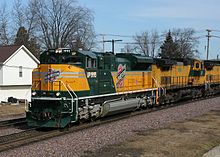 UP Heritage Unit #1995 passes through Rochelle Railroad Park, with the two C&NW Dash 9 locomotives behind it
UP Heritage Unit #1995 passes through Rochelle Railroad Park, with the two C&NW Dash 9 locomotives behind it
Union Pacific continues to follow its new tradition of releasing "Heritage" units to represent the paint schemes of companies absorbed by UP. After completion of painting at the Wisconsin and Southern Railroad's Horicon, Wisconsin shop, UP 1995, an EMD SD70ACe locomotive painted in a "Heritage" C&NW paint scheme, was unveiled on July 15, 2006, at North Western Station in Chicago, Illinois. North Western Station now serves as UP's Metra terminus (although the station is officially designated the "Ogilvie Transportation Center", many locals still refer to the station as the "North Western Station", or as the "CNW Station"). The unit was then placed in dedicated service on former C&NW trackage, sometimes paired with the C&NW 8646 and 8701.
Passenger train service
The CNW's most famous train, the Twin Cities 400 from Chicago to Minneapolis/St. Paul, was introduced in 1935 to compete with the Chicago, Burlington and Quincy's Zephyrs and the Milwaukee Road's Hiawathas. This train was named because it traveled the 400 mi (640 km) between the cities in 400 minutes. CNW was the first system to start a high-speed Chicago-Twin Cities schedule because it used refurbished instead of new equipment, but in 1939, modernized the 400 with new E3A diesel locomotive pairs and streamlined cars. Other named trains the CNW operated included the Ashland Limited, Duluth-Superior Limited, and the North Western Limited[2] CNW eventually renamed the first 400 to the Twin Cities 400 as the CNW labeled almost all of its passenger trains with variations of the 400 moniker, including the Flambeau 400, Rochester 400, Valley "400", Shoreland "400", Valley "400", Dakota 400 and the Kate Shelley 400.[3] CNW ceased running the Twin Cities 400 in 1963, and all intercity passenger service on CNW ended with the formation of Amtrak in 1971.
In conjunction with Union Pacific and Southern Pacific, the North Western operated some long distance passenger trains including the Overland Limited, City of Los Angeles, City of San Francisco, City of Denver, and the Challenger. These services lasted from 1889 to 1955, after which the CNW route to Chicago was changed to the Milwaukee Road's on account of poor track conditions.
Chicago and North Western also operated commuter train service in the Chicago area, where they developed what was perhaps the first cab car. A modified gallery car was built in 1960 with locomotive controls to allow push-pull operation. Today, it is preserved at the Illinois Railway Museum.[4] The C&NW also pioneered the concept of Head End Power (HEP), generating 480V electricity from the locomotive to power the air conditioning, lighting, and heating on the new bi-level cars. This eventually became the standard for all railroads in the United States.
Three commuter lines radiated from North Western station, terminating in Geneva, IL; Harvard, IL; and Kenosha, WI. All three are still operated by Metra. A branch line on the mainline to Harvard also served Williams Bay and Lake Geneva, WI, but was then pared back to Richmond, IL by the 1970s.
In 1974, responsibility for the commuter lines and equipment ownership was transferred to the newly formed Regional Transportation Authority, later branded in 1983 as Metra. A "purchase of service" contract was signed with the C&NW, by which the railroad would be paid to maintain the line and operate trains on behalf of the RTA. This arrangement continues with the Union Pacific today.
All three C&NW commuter lines live on in the Metra system, with the Geneva line having been extended to Elburn, IL, however service on the McHenry Branch was ended at Ringwood in 1979, and Richmond in 1981. Rails and ties north of the Cargill plant in Ringwood were removed.
Named passenger trains
Chicago to Omaha and West on Union Pacific
- The Pacific, Streamliner City of Los Angeles, The Utahn, The Los Angeles Limited - Chicago to Los Angeles
- Streamliner City of Portland, The Pacific, The Idahoan - Chicago to Portland and Seattle
- Gold Coast, San Francisco Overland, Streamliner City of San Francisco - Chicago to San Francisco
- City of Denver - Chicago to Denver
- Kate Shelley 400 - Chicago to Omaha
Chicago to Minneapolis/St. Paul
- Twin Cities 400
- Viking
- Victory
- North Western Limited
Minneapolis/St.Paul to Omaha
- The North American
- Mondamin
Recorded in the "Remember When" section of the Savage Minnesota Pacer Paper, published March 6, 2010. This was originally reported in the Shakopee Minnesota Argus Tribune April 11 of 1942: "Six people were killed and 50 injured when the Omaha Nightingale plowed into the rear of the Omaha Modamin, which stopped on the tracks after it struck a car near a grade crossing in Savage on April 11, 1942. Many residents of Savage rushed to the scene to help. The Modamin hit a car driven by Donald A. Johnson, 19, of Bloomington Minnesota, who died 3 days after the crash. The brakemen of the Modamin tried to warn the crew of the ongoing Nightingale of the crash by setting torpedo torches and running down the track to flag down the oncoming train. But, blinded by the morning sun, the enginemen failed to see the brakeman. Once they saw the torpedo torches, the Nightingale crew made an emergency brake application and leapt from the cab. But the locomotive and first passenger car plunged into a baggage car at the rear of the Modamin. The tragedy is recorded as one of the areas worst railroad accidents."
- Nightingale
Chicago to Wisconsin cities
- Capitol 400 and The Madisonian – Chicago to Madison, WI
- Duluth Superior Limited – Chicago to Duluth Superior
- Commuter 400
- City of Milwaukee
- Shoreland 400 – Chicago to Green Bay
- Flambeau 400 and Ashland Limited - Chicago to Ashland, WI
Chicago to Iron and Copper Country (Northern Wisconsin/Michigan Upper Peninsula)
- Valley 400 – Chicago to Menominee, MI
- Peninsula 400 and Iron and Copper Country Express – Chicago to Ishpeming, MI
Chicago to Rapid City via Southern Minnesota
- Minnesota 400 (later Dakota 400)
- Minnesota and Black Hills Express
- Rochester-Minnesota Special (later Rochester 400)
Additional notes
The CNW was known for running "left-hand main" on double track mainlines. In other words, traffic was routed by default to the track on the left rather than the track on the right. In the United States, most railroads followed the "right-hand main" operating practice, while "left-hand main" running was more common in countries where automobile traffic drove on the left as well. According to a display in the Lake Forest station, the reason for this was a combination of chance and inertia. When originally built as single-line trackage, the C&NW arbitrarily placed its stations on the left-hand side of the tracks (when headed inbound toward Chicago). Later, when a second track was added, it was placed on the side away from the stations so as not to force them to relocate. Since most passengers waiting at the stations were headed toward Chicago, the inbound track remained the one closest to the station platforms. The expense of reconfiguring signals and switches has prevented a conversion to right-hand operation ever since.
The Chicago and North Western was known for its installation of Western Railroad Supply Company wigwag signals at many of its crossing in the 1920-1940's. Almost every town on their route had at least the main crossing in town protected by them. The most common style were the Center Harp shorties. They were almost iconic to the CNW. Many of them, which were grandfathered in after the Federal Railroad Administration ruled them inadequate protection in 1949, survived until the 1970s and a few remain on lines in Wisconsin that have been sold off to other railroads. Lack of available parts and upgrades to roads have replaced all but a few of them.
The railroad also purchased a great deal of its equipment second-hand. CNW shop forces economized wherever possible, earning the railroad the nickname "Cheap and Nothing Wasted." Sometimes employees referred to the condition of equipment as "Cardboard and No Wheels."
The Cowboy Trail is a rail trail which follows the abandoned CNW line between Chadron, Nebraska and Norfolk, Nebraska. When completed, it will be 321 miles in length.
Finally, the CNW has a following of more than 3,000 members of the Chicago and North Western Historical Society.
Notable employees
- Carl Ingold Jacobson, Los Angeles, California, City Council member, 1925-33
See also
- Category:Chicago and North Western Railway locomotives
References
 Roundhouse wipers at lunch, 1943. Jack Delano, photographer.
Roundhouse wipers at lunch, 1943. Jack Delano, photographer.
- ^ "Chicago & North Western 1385". midcontinent.org. http://midcontinent.org/collectn/steam/cnw1385.html. Retrieved 2007-09-10.
- ^ Chicago And North Western System [Time Table]. Rand McNally, March 14, 1948
- ^ Scribbins, Jim (2008). The 400 Story. Minneapolis/London: University of Minnesota Press (originally published by PTJ: Park Forest, IL, 1982). ISBN 978-0-8166-5449-9.
- ^ Dave Phillips (September 1999). "C&NW Gallery Cars". Rail & Wire. Illinois Railway Museum. http://www.irm.org/railwire/rw179a1.html. Retrieved January 6, 2010.
- Grant, H. Roger (1996). The North Western – A history of the Chicago & North Western Railway system. Northern Illinois University Press, DeKalb, IL. ISBN 0-87580-214-1.
- Grant, H. Roger (1984). The Corn Belt Route – A history of the Chicago Great Western Railroad Company. Northern Illinois University Press, DeKalb, IL. ISBN 0-87580-095-5.
- The Trains staff (November, 1990). Timeline. Trains, pp. 21–47.
- (1973). Handy Railroad Atlas of the United States. Rand McNally & Co. p. 53.
- Piersen, Joe (2004). "Chicago and North Western- A Capsule History". Chicago and North Western Historical Society. http://www.cnwhs.org/ch_cnw.htm. Retrieved 2007-09-10.
External links
- Chicago & North Western Historical Society
- Chicago and North Western Photographs from the Western Historical Manuscript Collection at the University of Missouri–St. Louis
- List and Family Trees of North American Railroads
1864 Peninsula Railroad1882 Escanaba and Lake Superior Railway1889 Iron Range Railway - Iron River Railway1891 Paint River Railway1893 Milwaukee, Lake Shore and Western Railway1947 Escanaba, Iron Mountain and Western RailroadClass I railroads of North America Current Former
(1956–present)AA · ACL · AC&Y · AGS · A&SAB · AT&N · AT&SF · AUT · A&WP · B&AR · B&LE · B&M · BN · B&O · CAR&NW · CB&Q · C&EI · CG · CGW · C&IM · CNJ · CNO&TP · C&NW · C&O · CPME · CR · CRI&P · CRR · C&S · CSPM&O · CV · C&W · C&WC · D&H · DL&W · DM&IR · D&RGW · DSS&A · DT&I · D&TSL · DW&P · EJ&E · EL · ERIE · FEC · FW&D · GA · GB&W · G&F · GM&O · GN · GS&F · GTW · IC · ICG · ITC · KO&G · L&A · L&HR · LI · L&M · L&N · L&NE · LS&I · LV · MEC · MGA · MI · MILW · MIS · MKT · MN&S · MON · MP · M&STL · NC&STL · NH · NKP · NO&NE · NP · NS · N&W · NWP · NYC · NYCN · NYO&W · NYS&W · PC · P&LE · P&N · PRR · PRSL · P&WV · RDG · RF&P · RUT · QA&P · S&A · SAL · SBD · SCL · SD&AE · SI · SIRT · SLSF · SLSFTX · SN · SOU · SP · SP&S · SSW · TC · TFM · TM · T&NO · T&P · TP&W · VGN · WA · WAB · WC · WM · WP(pre–1956) A · AB&A · AB&C · AC · A&D · AE · A&NM · A&STL · A&V · BA&P · BC&A · B&G · BRI · BR&P · B&S · BSL&W · C&A · CA&C · C&C · CC&CS · CCC&STL · CD&C · C&E · C&G · CH&D · C&I · CINN · CI&S · CI&W · CL&N · CM · CM&PS · CNE · CNNE · CNOR · C&OIN · CP&STL · CPVT · CRI&G · CR&NW · CRP · CS · CTH&SE · CV&M · CVRR · DGH&M · D&IR · D&M · DM&N · DNW&P · D&SL · EI&TH · EP&SW · E&TH · F&CC · FJ&G · FS&W · FW&RG · GC · GC&SF · GH&SA · GM&N · GR&I · G&SI · HE&WT · H&TC · HV · ICRY · IGN · ISRR · KCM&O · KCM&OTX · K&M · LA&SL · LA&T · LE&W · LH&STL · LR&N · LR&NTX · LS&MS · LW · MTR · M&A · MC · MD&V · M&I · MKTTX · MLR · ML&T · M&NA · M&O · MO&G · MSC · MSP&SSM · MV · NAL · NCRY · NJ&NY · NN · NOGN · NOM&C · NOT&M · NYP&N · OCAA · OE · OR&L · OSL · OWRN · PB&W · PCC&STL · PCO · PE · P&E · PERK · PM · P&NT · PRDG · P&S · P&SF · PS&N · QO&KC · SA&AP · SAU&G · SB&NY · SD&A · SFP&P · S&IE · SIND · SJ&GI · SKTX · SLB&M · SLIM&S · SOUMS · SSWTX · SUN · T&BV · T&FS · T&N · T&OC · TSTL&W · U&D · UTAH · VAND · VS&P · V&SW · WF&NW · WF&S · WJ&S · W&LE · WPT · WSN · WV · Y&MVTimeline 1910–1929 · 1930–1976 · 1977–presentCategories:- Chicago and North Western Railway
- Railway companies established in 1972
- Railway companies disestablished in 1995
- Predecessors of the Union Pacific Railroad
- Former Class I railroads in the United States
- Defunct Illinois railroads
- Defunct Iowa railroads
- Defunct Kansas railroads
- Defunct Michigan railroads
- Defunct Minnesota railroads
- Defunct Missouri railroads
- Defunct Nebraska railroads
- Defunct North Dakota railroads
- Defunct South Dakota railroads
- Defunct Wisconsin railroads
- Railroads in the Chicago Switching District
- Defunct Wyoming railroads
- Blackstone Group companies
Wikimedia Foundation. 2010.

